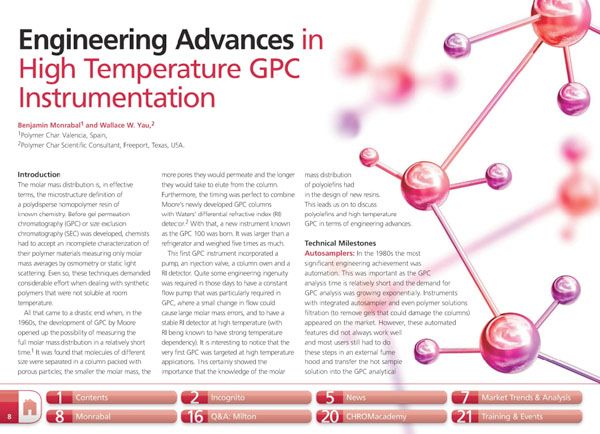Engineering Advances in High Temperature GPC Instrumentation
We discuss polyolefins and high temperature GPC in terms of engineering advances.
The first GPC instrument incorporated a pump, an injection valve, a column oven and a RI detector. Quite some engineering ingenuity was required in those days to have a constant flow pump that was particularly required in GPC, where a small change in flow could cause large molar mass errors, and to have a stable RI detector at high temperature (with RI being known to have strong temperature dependency). It is interesting to notice that the very first GPC was targeted at high temperature applications. This certainly showed the importance that the knowledge of the molar mass distribution of polyolefins had in the design of new resins. This leads us on to discuss polyolefins and high temperature GPC in terms of engineering advances.
Detecting Hyper-Fast Chromatographic Peaks Using Ion Mobility Spectrometry
May 6th 2025Ion mobility spectrometers can detect trace compounds quickly, though they can face various issues with detecting certain peaks. University of Hannover scientists created a new system for resolving hyper-fast gas chromatography (GC) peaks.
University of Oklahoma and UC Davis Researchers Probe Lipidomic Profiles with RP-LC–HRMS/MS
May 6th 2025A joint study between the University of Oklahoma Health Sciences Center (Oklahoma City, Oklahoma) and the UC Davis West Coast Metabolomics Center (Davis, California) identified differentially regulated lipids in type 2 diabetes (T2D) and obesity through the application of reversed-phase liquid chromatography-accurate mass tandem mass spectrometry (RP-LC-accurate MS/MS).
Automated Sample Preparation (ISO 20122) for MOSH/MOAH in Seasoning Oils
May 6th 2025This work presents an Automated Sample Preparation procedure for MOSH/MOAH analysis of Seasoning Oils. We compare results from a manual epoxidation procedure compliant with DIN 16995 with results based on fully automated sample preparation (epoxidation and saponification) compliant with ISO 20122. In both cases, online clean-up via activated aluminum oxide (AlOx) are used to remove interfering n-alkanes from the MOSH fraction during the HPLC run. Automated data evaluation using a dedicated software (GERSTEL ChroMOH) is presented.

.png&w=3840&q=75)

.png&w=3840&q=75)



.png&w=3840&q=75)



.png&w=3840&q=75)











